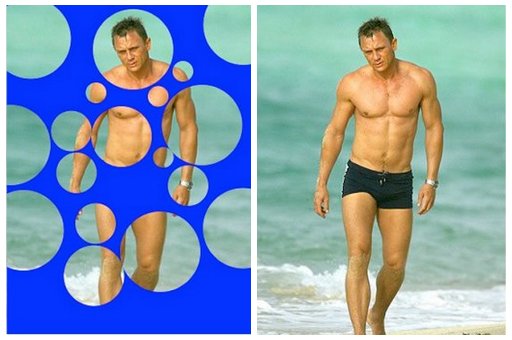Making Bubble Porn
Perhaps you’ve seen the “bubbling” video that’s been going around lately:
It’s actually rather fun; by strategically masking over the clothed parts of an image, scantily-clad persons can be made to appear nude.

Your eyes and brain do the rest:
how can such a simple illusion look so convincing to our — admittedly kinky — eyes? The answer is actually threefold.
Let’s start with gestalt psychology, explaining how our perception of reality doesn’t really come from the actual sensorial stimuli, but from our instinctive recognition of complex patterns by a few of their composing elements. Emoticons are a good example: two dots and one curved line are enough to identify a smiling face, and this says a lot about how large is the role played by imagination in what we believe we are seeing.
The second part comes from physiology. The spot where our optic nerve connects to the retina, in the back of our eye, is not the most sensitive as you would instinctively believe; on the contrary, it is completely blind — hence the name of ‘blind spot’. The reason we are not aware of it is that our brain automatically deduces what’s in that minuscule area of our field of vision by its surroundings, and of course by what the other eye is seeing. Our mind and eyes are constantly “imagining” things: with bubble porn they simply tend to complete the picture in the most likely way. But why is our brain filling the blanks with smut?
Here comes the last part of the answer, thanks to evolutionary biology. Turns out that two of the most useful skills for animal survival are recognizing other individuals of your own species, and evaluating their suitability for reproduction, aka ‘sex’. These functions are so fundamental that they are controlled by our so-called “reptile brain”, the innermost part, working on a completely instinctive level. Since in the natural state people are not clothed and sex is something you do while naked, our most instinctual part still tends to look for naked, sexy bodies.
Bubbling is a big deal in certain corners of the internet; there’s a lively Reddit ( /r/bubbling ) where the art is practiced, and if you want to do it yourself, there’s a detailed tutorial for accomplishing it in Photoshop.
Unfortunately if you’ve seen the bubbling video elsewhere, you may also have seen the lame viral-bait claim that bubbling was invented by a young horny Morman man. That claim dates to 2010, but it’s completely bogus; in fact, bubbling in its modern Photoshop form arose in a Japanese forum in 2007, having antecedents in a more analog approach that used 10-yen coins. This isn’t obscure knowledge; after less than ninety seconds of searching, it popped up for me on Know Your Meme.
That leads to the interesting question of why most of the major “hey, look!” sites like Gizmodo are circulating this with the obviously-too-good-to-be-true and easily-debunked “horny/lonely Mormon lad” legend. But it’s a question that sort of answers itself in the asking. In our modern world, virality trumps truth every time. If it’s too good to be true, but the truth won’t get as many likes and reblogs, the current web publishing standard is to ask no questions and hit the “publish” button as fast as possible.
Similar Sex Blogging:
Shorter URL for sharing: http://www.erosblog.com/?p=11771








It’s so cool to be mentioned by this blog! Thank you, and do stop by for more news from the world of unusual sex!